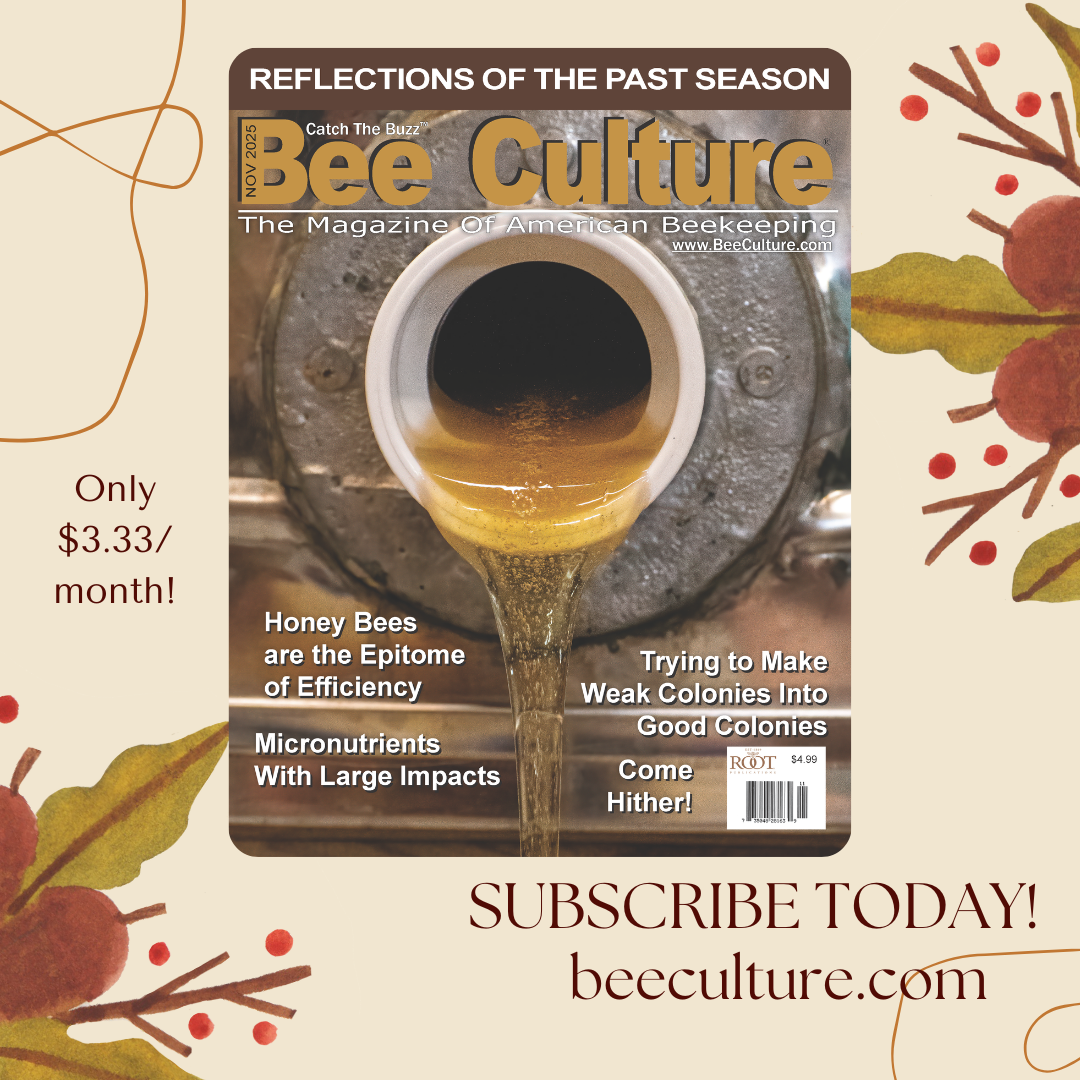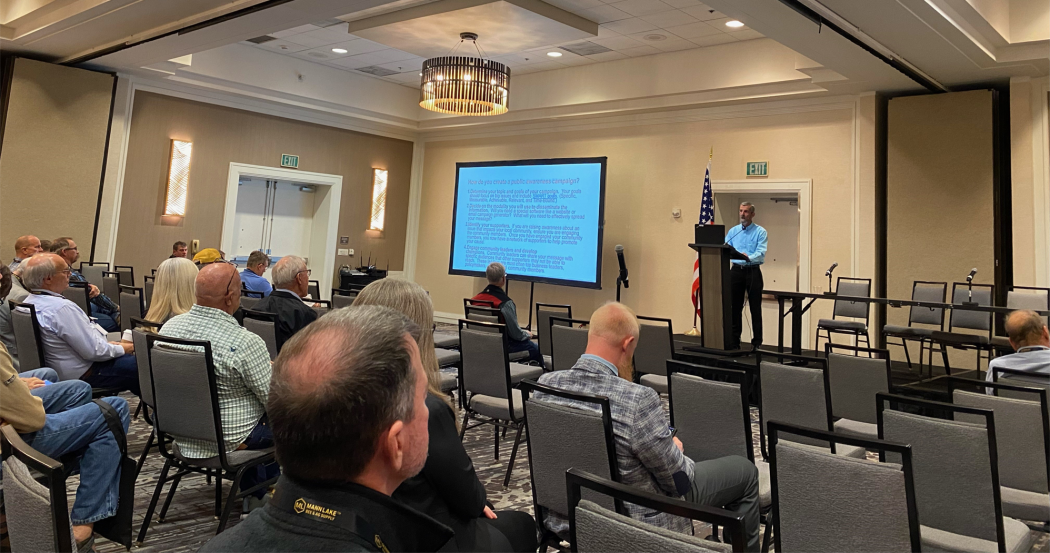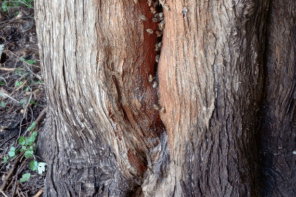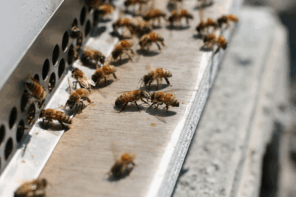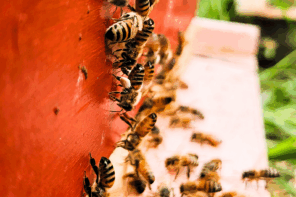 Study Hall – From the Editor
Study Hall – From the Editor
By: Jerry Hayes
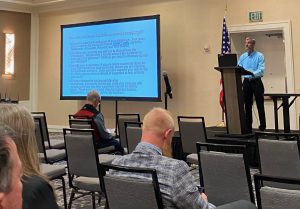
I was asked to present the Keynote Address at the American Honey Producers Association (AHPA) Conference this past Winter, titled Don’t Be Bashful. I have been asked if I would/could turn a 45-minute powerpoint into an article for Bee Culture. I have never done this before. Hang on, here goes.
In the United States, the population is calculated at approx. 333.3 million and growing, of people of all ages, ancestry, genders and sizes.

Jerry presenting at the AHPA conference
At this same time, the number of active beekeepers is somewhere between 115,000 and 125,000. This is ALL beekeepers – backyard hobbyists, sideliners and full-time commercial beekeepers.
This means that whoever is a beekeeper right now, you are only 0.04% of the U.S. population. As a comparison, yoga enthusiasts represent 10% of the population along with 10% of stamp collectors.
We beekeepers are an extremely small percentage of the U.S. population, but the value you bring as a honey bee manager for total food production and environmental stability is huge in comparison to yoga enthusiasts, stamp collectors and many others.
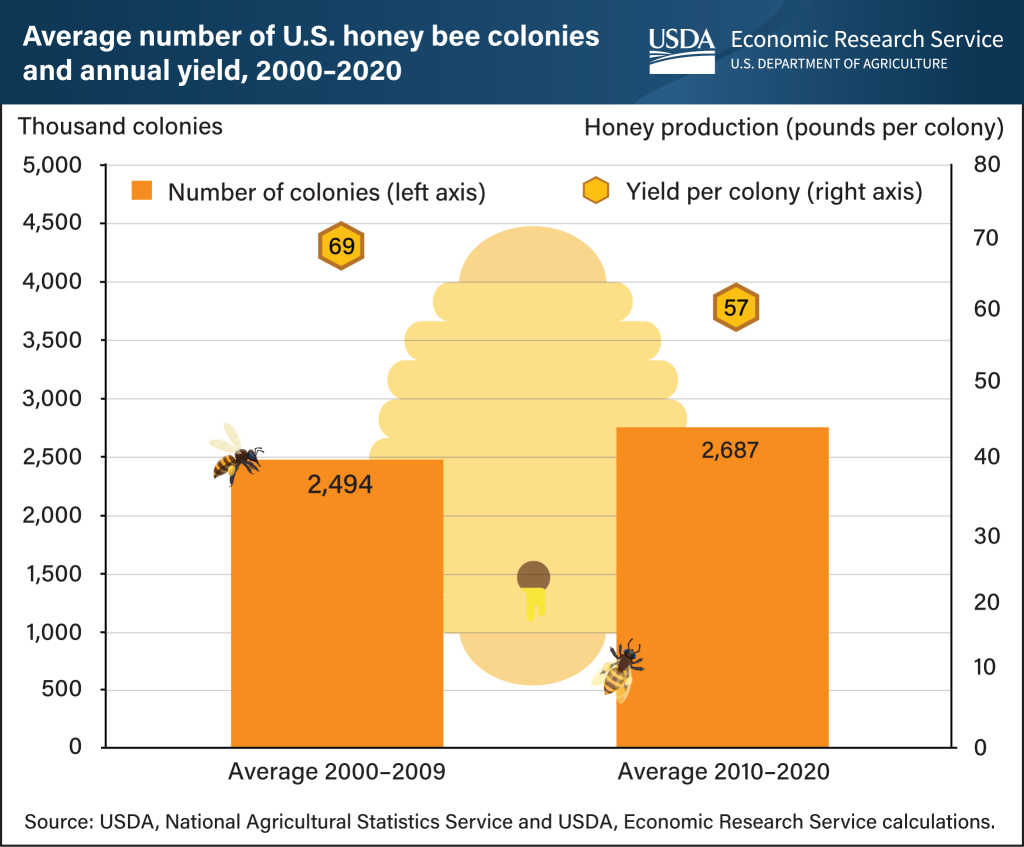
Image 1
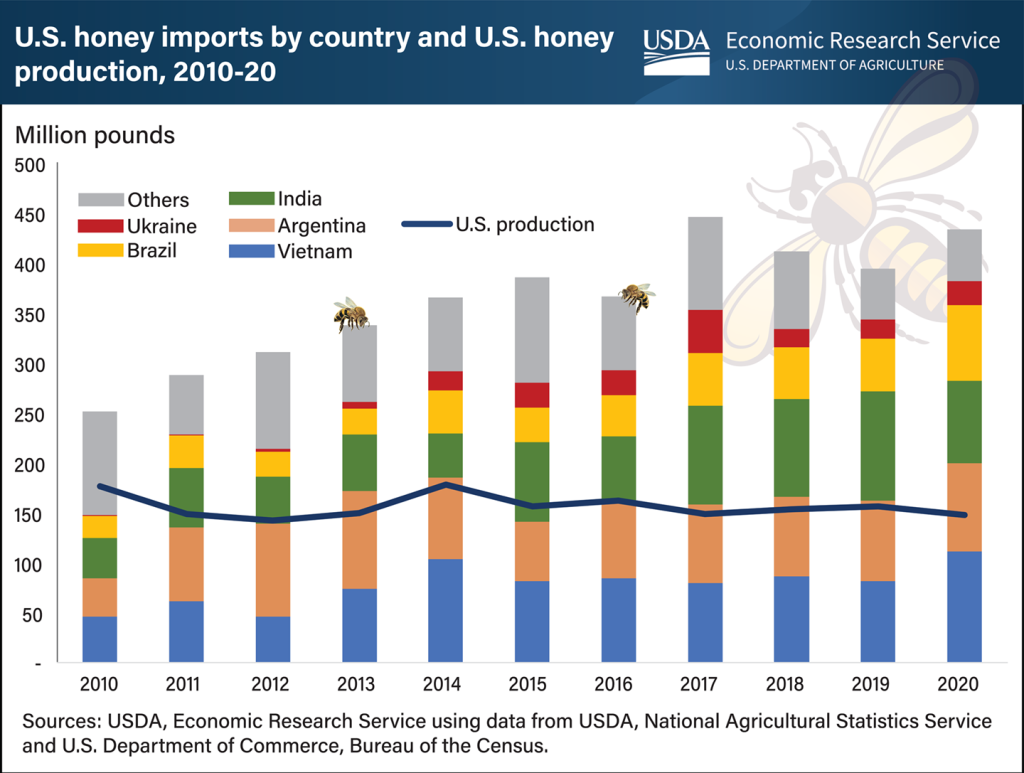
Image 2
According to USDA reports, the 2.67 million colonies of honey bees in the U.S. that you manage from one in your backyard to the 2.2 million managed by commercial beekeepers, produced 125 million pounds of raw honey in 2022. See image 1. But that production was overwhelmed by imports. Take a look at the graph. See image 2.
Unfortunately, not all imported honey is real honey. In order to make the goal of more money, there are cheaters who are constantly testing our import system and most times may be winning by sneaking adulterated honey into the U.S.
What is adulterated honey? It began as all honey’s may, by forager honey bees collecting flower nectar, converting it into a low moisture concentrated honey, then harvested/extracted in another part of the world. Then a packer/bottler in another country adds other ingredients such as HFCS, artificial sweeteners, chemicals like gypsum and even water, to turn one pound of pure honey into over one pound of fake honey. There are tests that can be performed on imported honey of interest. See image 3.
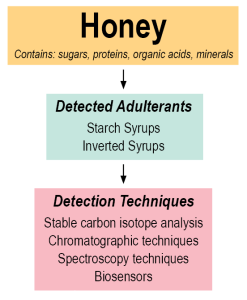
Image 3
But this ID of possible product irregularities and ID tests are not done enough at the borders. As a result, adulterated / fake honey is not identified many times and makes its way to the “big box store” shelves. And that customer who has heard of the value of honey nutritionally does not know what “real” honey looks or tastes like, as you do. So, they are sold fake honey. This hurts our industry, our reputation and honey bees tremendously.
As honey bees are visiting flowers to collect nectar to convert to honey for there own food needs along with pollen for brood production, they transfer pollen (male element) from the flower anther to the stigma in a process called pollination. The pollen releases “sperm” which fertilizes a seed embryo, and a healthy seed is formed. Some seeds are large like almonds, and some are surrounded by edible fruit to protect and feed the seed such as apples, peaches, blueberries, melons, etc. In the U.S. specifically, honey bees contribute an estimated $20,000,000,000 to U.S. fruit, nut and veg production, for us.
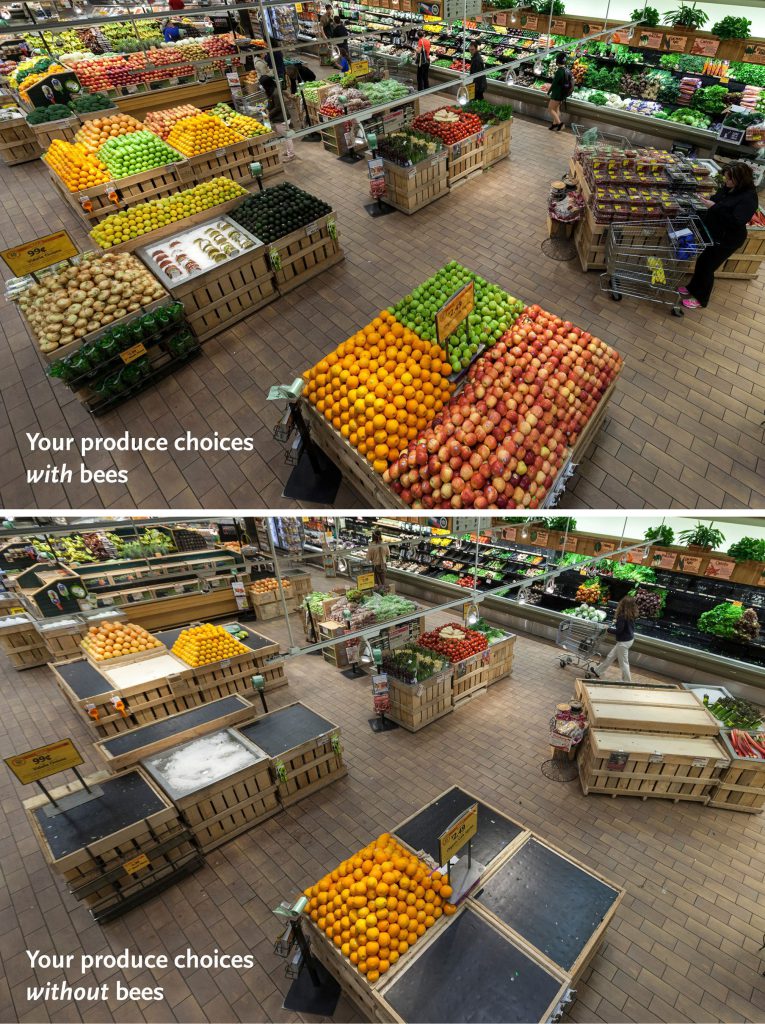
Image 4
When you walk into your grocery store, you don’t walk into the aisle with the toilet paper and the cleaning supplies, do you? You walk into the produce section. This is where the connection to flavor, color, aroma and nutrition is located. And this is where you and honey bees make a marvelous positive influence.
And that $20 billion is even larger when you factor in you and your neighbors and community’s backyard gardens, fruit trees and berry bushes in suburbia. Honey bees forage and visit pollinator friendly plants in a two to 2.5-mile radius of their colony providing for additional wild fruit, nuts, seeds, vegetables, etc. so plants can reproduce and wildlife be fed.
Without you and your honey bees, about ⅓ of our food would simply disappear. You are needed, dramatically. See image 4.
But in 2024, what you do and how you do it is not easy. You have pests, parasites and disease to control (see image 5), you have weather and climate change and availability of honey bee friendly flowering plants.
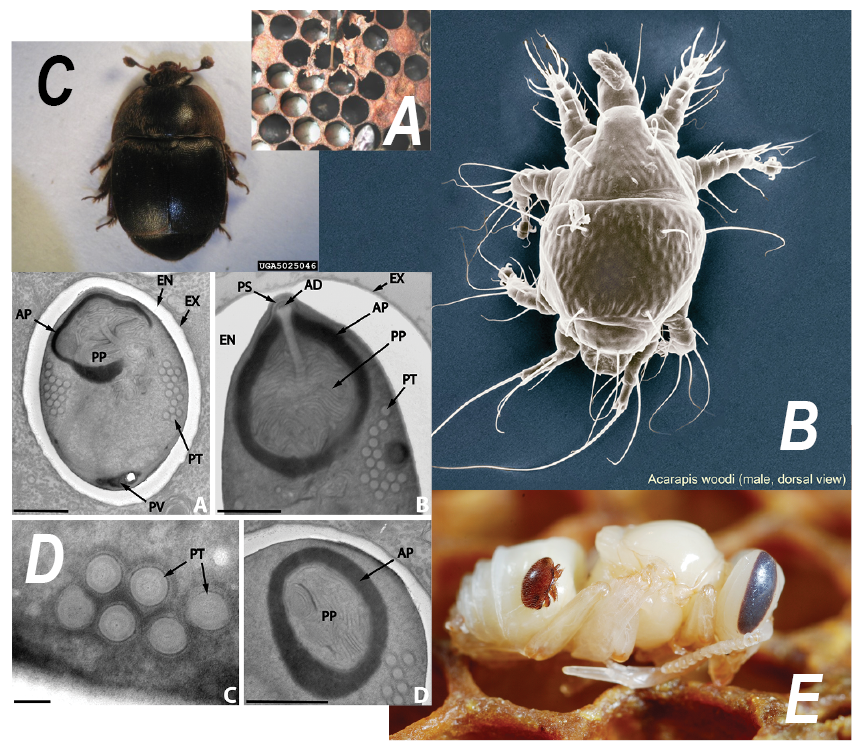
Image 5. A – American Foulbrood, source: Pollinator; B – Tracheal Mite, source: USDA; C – Small Hive Beetle, source: USDA-APHIS; D – Nosema, source: Toguebaye, B. S., Quilichini, Y., Diagne, P. M. & Marchand, B. 2014: Ultrastructure and development of Nosema podocotyloidis n. sp. (Microsporidia), a hyperparasite of Podocotyloides magnatestis (Trematoda), a parasite of Parapristipoma octolineatum (Teleostei). Parasite, 21, 44. doi:10.1051/parasite/2014044; E – Varroa Destructor on a bee nymph, source: https://www.flickr.com/photos/sanmartin/5048094767/
If you are a commercial beekeeper with thousands of colonies, you have all of the previous but at a much higher business expense and overhead reality. I asked for and was given the information from a successful commercial beekeeper of the costs for basic production inputs for 7,000 colonies (see table 1). Look at the cost rise. If you are a small business, how do you pass on costs like this?
For all these pluses and minuses, we can’t do it alone. We are a vital part of agriculture, production and backyard, along with the environment that sadly, no one has calculated the dollar value of health and stability of during climate change ahead.
This is where the AHPA comes in. The American Honey Producers Association (AHPA) is an organization with over 550 members that are commercial beekeepers making their living from the production of honey. The AHPA is dedicated to promoting the common interest and general welfare of every American honey producer. From the backyard beekeeper to large commercial beekeeping, whether you run one to two hives or 80,000 hives, the AHPA pledges to work to improve the future of beekeeping for all (https://ahpanet.com/). But the AHPA can’t do everything for everybody without your active and engaged help.
| Table 1. Approx. Costs – 7000 Colonies | ||
|---|---|---|
| 2019 | 2023 | |
| Pollen Supplement (Feed) | $0 | $187,142 |
| Queens | $217,411 | $502,065 |
| Pest, Parasite, Disease Control | $58,380 | $112,598 |
| Labor | $183,837 | $511,321 |
Does the general voting public, your neighbors, your community, your church and more care about honey bees? Do they even know about managed honey bees and how our industry needs them? If they don’t know about honey bees or you, that means they have no reason to care and support us. If pollinator dependent food always shows up magically in the produce section, why be concerned?
We have done an extremely poor job of marketing and advertising ourselves collectively as beekeepers and the vital need for managed honey bees, managed by you. As a result, the general voting public that can and must support our industry has little idea of fake honey, or that it takes multiple flower visits to pollinate and fertilize the seven to 10 seeds in an apple or you don’t get an apple. A female watermelon flower will need around 500-1000 pollen grains to be fertilized effectively. This will require a minimum of eight visits by a honey bee for seeded watermelons. In seedless watermelon, more visits will be required. A blueberry flower requires at least 10 visits from a honey bee. Blueberry flowers need 10-15 visits from a honey bee to produce those big, juicy berries. And I could go on. We beekeepers are considered an interesting Ag. overhead, just like fertilizer, crop control and irrigation. We are not really considered needed. We can take a 40% loss, and the colonies left we can split and divide and make up the loss. But is this an efficient and practical management scheme? The plan is the U.S. could import more fruits, nuts and berries along with honey. Because nobody knows about us… Really, they don’t.
We absolutely must change this perception of us as simply honey bee (livestock) managers positively and quickly.
Here are some ideas.
If we are going to advertise and market ourselves and our industry, what are our goals? What are the big issues we need to share and highlight? We must be SMART, Specific, Measurable, Achievable, Relevant and Time-bound.
How do we get information out? Websites, podcasts, video calls, YouTube and more.
Who are our supporters right this minute? Is it your neighbors, community, work colleagues, students, FFA, 4-H, Farm Bureau etc.?
Who are the thought leaders in your world? They can reach people and groups you can’t.
What is the media strategy? What will you use? Social media? Ad space in magazines, newsletters, newspapers? And how often do you use these to share your important message?
Now, back to SMART. What’s the agreed-on plan? What are the individual steps so you can monitor progress?
You need to have a specific budget, fundraising ideas and forward strategies.
I have been a beekeeper and in this amazing industry ever since I was young and good looking. Now, I am not and I am truly concerned that we are a small, continually segregated industry that is devalued by many. And this has not changed much over my tenure. How do we gain positive, solid, valuable attention? Because now we are considered a weird, unique industry that is only 0.04% of the total U.S. population. But it will require you to stand up tall and tell the wonderful story of beekeeping. Or we could all just forget it and become yoga instructors or stamp collectors.




